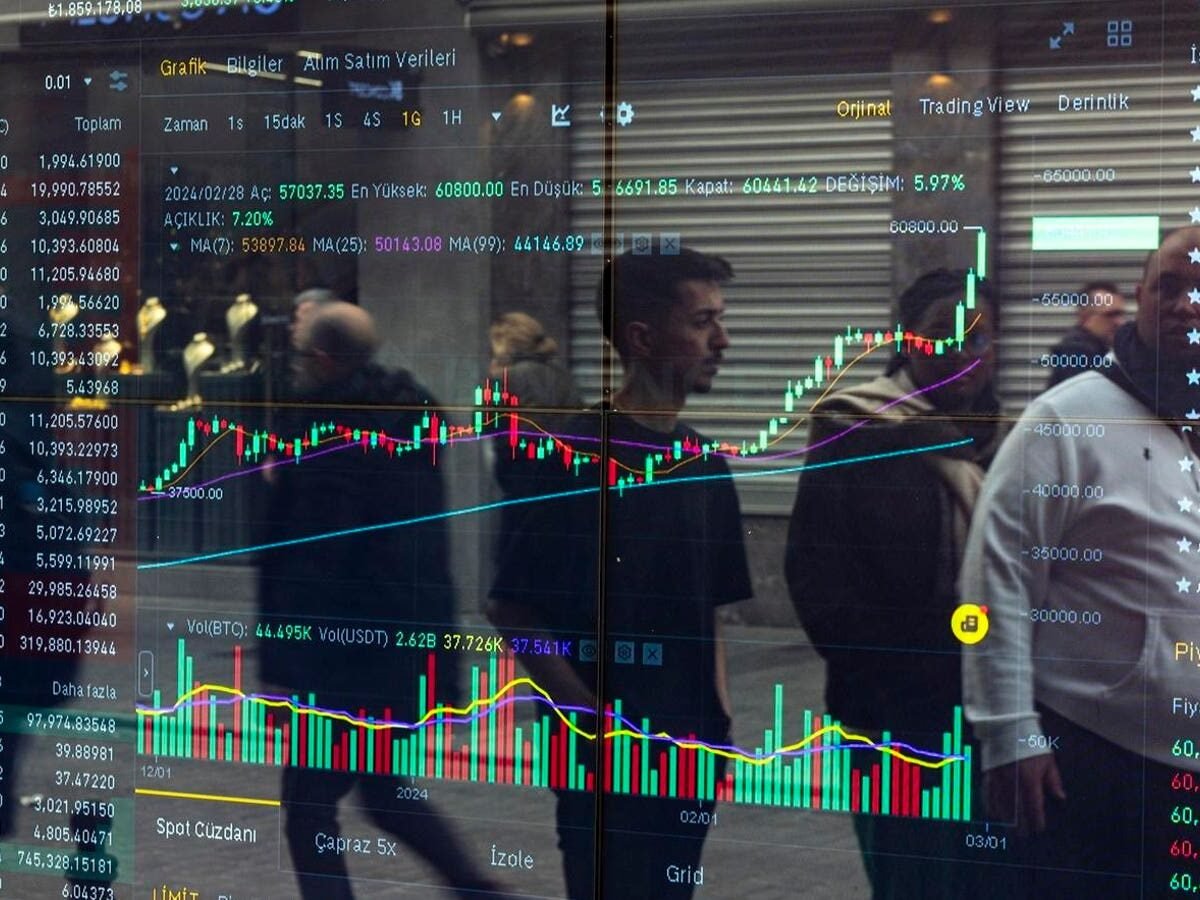People are passing by a Bitcoin office in Istanbul, Turkey, on February 28, 2024. (Photo by Umit … [+]
The news that in Turkey some 4% of GDP is already going on buying stablecoins is certainly surprising but it is not — at least to people who read my book The Currency Cold War — shocking. The Turkish Lira (TRY) is in fact the fourth most used fiat currency in the cryptocurrency world, as stablecoins and “meme coins” have surpassed even Bitcoin in the country. Right now, USDT-TRY (ie, Tether) is the largest trading pair by volume on Binance, reaching over $22 billion, more than five times greater than the next largest pair which is (astonishingly) PEPE-USDT, which has $4 billion. What might this mean for the country?
Dollar Dollar Bills
In that book I talked about the difference between “prime” currencies (eg, the US Dollar) and “permeated” currencies. Permeated currencies exist and are used in general circulation but are supplanted by other currencies for transactions that matter. I can illustrate the latter category from personal experience: many years ago, I lived in a developing nation where all transactions of any significance (eg, my rent) were executed in US Dollars whereas the local currency was used for day-to-day transactions such as shopping and transport. Anyone accumulating any reasonable amount of the local currency would change it to US Dollars at the first opportunity. While the economy was not dollarised, it was permeated by US Dollars.
Now, that was back at a time when getting, storing and transferring US Dollars was constrained. Only the well-off had dollar bank accounts and could wire money into and out of the country. For those forced to transact in cash, getting and transporting physical US currency was a problem. I can well remember pushing a small barrow full of local currency to a travel agent to buy a plane ticket because for some reason (I forgot why exactly) they could not take Dollars!
The printers can’t take much more this Jim.
Well, that was then. This is now, and getting, storing and transferring electronic US Dollars is no longer the province of the wealthy with their foreign bank accounts and dollar credit cards. In Turkey, as in a number of other countries, more and more people are moving their money into stablecoins, and these stablecoins are almost without exception US Dollar stablecoins. It is misleading to refer to this trend as being about cryptocurrency adoption, since it has always seemed to me to be the case that cryptocurrency demand in developing nations is largely a proxy demand for dollars anyway.
The Financial Stability Board (FSB), an international body that monitors and makes recommendations about the global financial system, recently published its report on crypto-assets and global stablecoins which warned that developing economies may be exposed to macro-financial risks arising from the use of coins backed by foreign fiat currencies (digital currency boards, if you will). These can increase financial stability risks by “destabilising financial flows and straining fiscal resources”. In particular, they note that a stablecoin may become systemic in an emerging economy (ie, permeate it) before reaching the threshold for becoming systemically important in the jurisdiction where it is domiciled.
These risks are significant. If we continue with the interesting case study of Turkey and speculate on the implications of Turks increasingly choosing to use stablecoins pegged to the US dollar instead of the local currency, that would have a major impact on the country’s economy, even putting to one side the fact that the Turkish central bank would have less control over the country’s money supply and its ability to implement effective monetary policy. In straight economic terms, a falling demand for theTurkish Lira could also lead to its further devaluation which would exacerbate inflation making it harder for people to afford basic goods and services.
(The banking sector might suffer too, because of reduced deposits as people shift to dollar-denominated digital assets for their savings and this could impair their ability to lend, potentially leading to a credit crunch.)
Any government would face major difficulties in regulating an economy that operates increasingly with proxy dollars. The switch to stablecoins might undermine tax collection, anti-money laundering efforts and overall governmental oversight. While the shift from the Turkish Lira to stablecoins might provide some short-term stability for individual savings, it also could bring long-term uncertainty to Turkey’s monetary policy, financial stability, and economic health in the long-term.
Stablecoins Are Spreading
Turkey is not the only country to see stablecoins signalling change and while it is certainly true that much global stablecoin activity is just automated bot-vs-bot speculation and trading – Visa’s detailed examination of the volumes shows that around 90% of volume is what they term “inorganic” — there is no doubt that stablecoins have real utility. That is, to support trade and commerce and (therefore) prosperity.
Writing in the Harvard Business Review, Christian Catalini and Jane Wu say that the companies that control the stablecoin market will wield substantial influence over the future of money. Indeed they will. I’ve said before that digital currency is a new space race, and it seems to me that it is in America’s interests to win it now that US Dollar stablecoins are emerging as a digital alternative to the banking networks when it comes to delivering instant, cross-border transactions without the volatility associated with cryptocurrencies.





